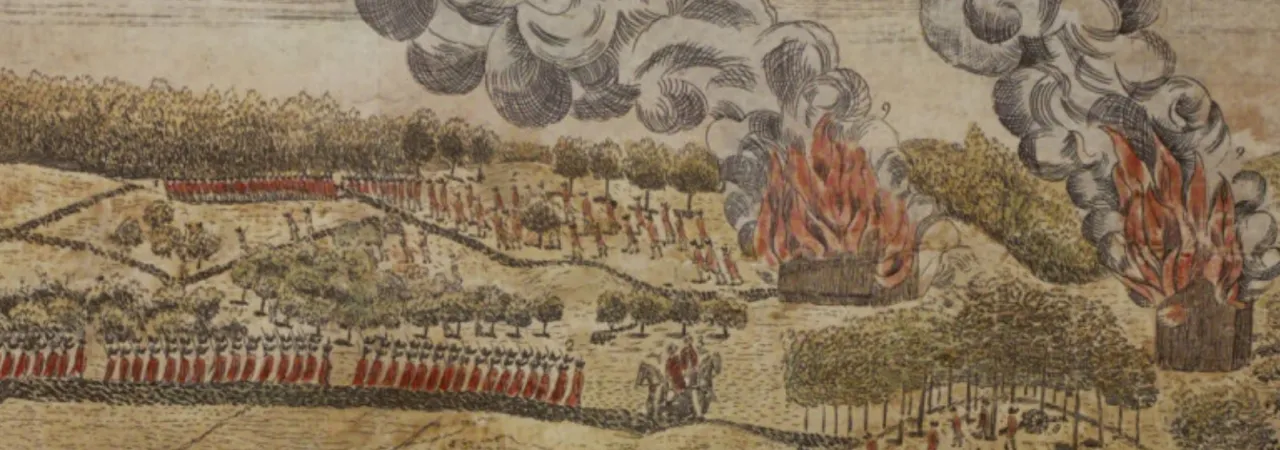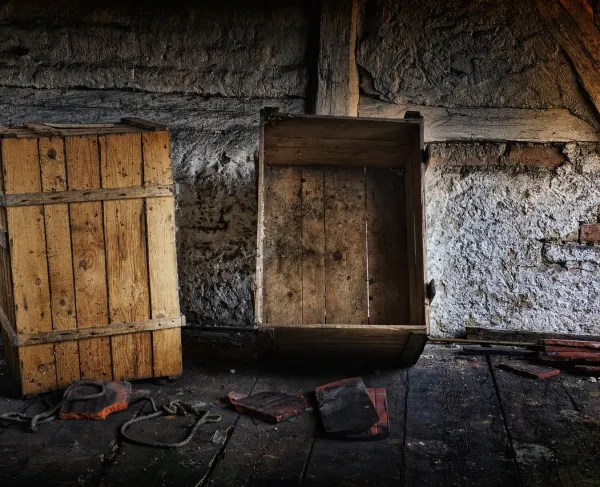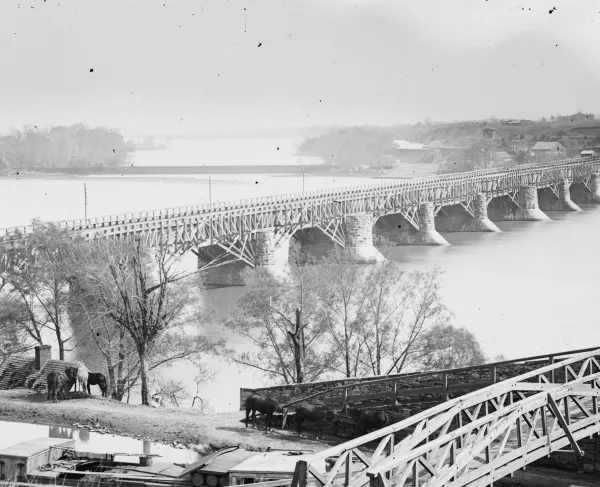
Abatis: A line of felled trees with their branches sharpened, tangled together, and facing toward the enemy. It strengthened fortifications by preventing surprise and delaying an attacking enemy once within the defenders’ range.
Advanced Works: Entrenched positions within supporting range in front of the main line of earthworks. They included rifle pits, picket lines, and vidette posts. They served as observation points and a first line of defensive positions.
Angle: Point where two faces of a fortification met. A reentrant angle pointed away from the enemy, a salient angle pointed toward the enemy.
Apex: Angle in a fortification closest to the enemy position.
Approach: Trench dug toward the enemy position.
Banquette: A raised step leading up to the rampart that served as a firing platform for defenders. The top was called the tread and the inclined plane leading up to the tread was called the slope. The banquette allowed defenders to fire and then step back to a covered position to reload.
Barbette: Raised platform or mound allowing an artillery piece to be fired over a fortification’s walls.
Bastion: A fortification projecting outward from the curtain. Bastions were designed to prevent attackers gaining shelter from the defenders’ fire.
Berm: Small horizontal space between the top of the ditch and the bottom of the parapet. It was designed to prevent earthwork from sliding back into its ditch. After completion of an earthwork’s construction, some engineers chose to minimize the berm’s size to prevent attackers from using it as a foothold while attempting to scale the wall.
Blockhouse: A log structure built to withstand attack from any direction, typically used to protect railroad bridges and depots. Blockhouses incorporated elements of fortification design and could have small ditches dug around them with the dirt piled against the outer log wall for additional structural support. The walls had loopholes and embrasures to allow the garrison to fire artillery and small arms in its defense.
Bombproof: A portion of the fortification designed to protect the garrison from enemy artillery fire. Bombproofs were built with heavy timbers and their roofs were covered with dirt.
Breach: A large gap in a fortification’s walls or embankments created by artillery fire or mine. This exposed the inside of the fortification to assault.
Breaching Battery: A designated artillery position constructed during siege operations to fire upon a vulnerable position in the enemy line, opening it up for assault. Breaching batteries were placed on the parallel lines closer to the enemy position.
Breastworks: Fortifications made of piled material (logs, fence rails, stones) usually built up to breast height. Typically converted to a rampart if used long-term.
Casemate: A sturdily-built, arched masonry chamber enclosed by a fortification’s ramparts or walls. Casemates were often used to protect gun positions, powder magazines, storerooms, or living quarters.
Chevaux-de-Frise: A defensive obstacle constructed by using a long, horizontal wooden beam (usually a log) with sharp wooden lances inserted as spokes at forty-five-degree angles to a present a spiked wooden fence. They were constructed before entrenching to use at the beginning of earthwork construction and provided a removable barrier that facilitated future forward movements.
Communication Trench: Smaller entrenchments that connected larger positions along the fortifications. These allowed the movement of troops and supplies.
Corduroy: A hardened surface created by laying parallel logs. A corduroy road, inside or outside of a fortification, was usable in wet weather.
Counterscarp: Outer sloped wall of the ditch.
Covered Way: A communication trench built to conceal movement.
Curtain: A line of fortifications connecting two bastions.
Defilade: Depressions in the natural contours of a landscape that allowed an attacking force to seek shelter from enemy fire.
Ditch: The deep trench dug around each earthwork. The ditch was typically in front of the fortification, but some advanced works had the ditch built behind the raised surface.
Earthwork: A field fortification constructed out of dirt. An earthwork could be a mound but typically consisted of a ditch and a parapet.
Embrasure: An opening or hole through the earthworks through which artillery was fired.
Enfilade: To fire along the length of an enemy’s battle line. Fortifications were frequently designed to maximize the potential for enfilading fire against an attacking force.
Entrenchments: Long cuts (trenches) dug out of the earth with the dirt piled up into a mound in front. They enabled a defending army to fight with advantage because it sheltered them from enemy fire, posed an obstacle to the enemy’s approach, and provided the means for defenders to effectively use their weapons. Name applied to all fieldworks. Frequently spelled historically as intrenchments.
Exterior Slope: The part of the rampart facing the enemy.
Fascine: Small branches tied into a bundle by wire or rope. The defensive purpose of fascines was to construct revetments, field magazines, and blinds or to reinforce earthworks, trenches or lunettes. They could also be used on the offensive to fill in a ditch.
Field Fortifications: Temporary entrenchments built to last for a short period (the operations of a single campaign). Typically built from dirt and wood. Also known as fieldworks.
Flank: The end, or side, of a military position. An unprotected flank was considered “in the air”, while a protected flank was referred to as being “refused.”
Fort: A fully enclosed earthwork.
Fortification: A man-made structure or portion of the natural terrain that made a defensive position stronger. Man-made fortifications were permanent (mortar and stone) or temporary (wood and soil). Natural fortifications included waterways, forests, hills, and swamps.
Fraise: Stakes or palisades placed horizontally along the berm or at the top of the counterscarp to stop or slow a climbing attacker. They prevented the earthworks from being taken by surprise or sudden assault.
Gabion: A cylindrical basket of woven sticks made in advance for quick use in building or repairing a parapet. Gabion were frequently filled with earth once placed into a fortification.
Glacis: Gentle slope leading up to the ditch in front of the fortification. The glacis was created to prevent attacking soldiers from taking cover while approaching the ditch.
Headlog: Wooden beam placed on top of parapet with a small amount of space underneath, providing cover for marksmen and allowing defending infantry to fire without exposing themselves.
Interior Slope: The part of the rampart on the side where the defenders are located.
Loophole: An opening in the fortification through which small arms could be fired.
Lunette: A fortification similar to a redan but consisting of two faces and two flanks. Like a redan, its rear is open.
Magazine: A fortified location, similar to a bombproof, where powder and supplies were stored.
Military Crest: The highest location on the slope of a hill that still allowed defenders to observe and fire upon the base of the hill. It was located below the topographic crest.
Palisade: A line of sharpened sticks angled toward the attacker to stop or slow their movement.
Parallel: A series of parapets connected by saps and constructed in sequence toward the enemy. Used when advancing by regular approaches in siege operations.
Parallel Fire: Musketry and artillery fire directed straight across the front of an entrenched position.
Parapet: The top of the rampart. Sometimes the term was used interchangeably with rampart.
Permanent Fortifications: Durable artificial defenses designed to last an extended amount of time, typically to defend cities, garrisons, or other fixed strategic positions.
Picket: Soldiers posted on guard ahead of a main force.
Priest Cap: Two redans placed adjacent to one another to provide enfilading fire.
Profile: A cross-section of a fortification, containing the rampart and ditch.
Quaker Guns: Large logs painted to resemble artillery piece. They were used to produce the impression that a fortification was of greater strength.
Rampart: A broad earthen mound surrounding a fortified place to protect it from artillery fire and infantry assault.
Redan: A fortification consisting of two faces jutting out past the rest of the defensive line of works who unite at a salient angle toward the enemy. Redans are open to the rear.
Redoubt: An enclosed fortification constructed to defend a position from attack from any direction.
Regular Approaches: Digging toward an enemy by use of saps, parallel and breaching batteries.
Revetment: Support for the embankment to protect against erosion, often made of wood, sandbags, gabion, or masonry.
Rifle Pit: A set of small fortifications (usually in advance of the main line) containing a short ditch with a low earthen wall in front.
Salient: The portion of a fortification jutting out toward the enemy. Can be vulnerable points because they can be attacked from multiple direction. They are nevertheless constructed to link already entrenched positions, to provide enfilading fire, or to follow the natural terrain contours.
Sally port: An opening left in a fortification during construction to allow passage to facilitate movement to the advanced works and toward the enemy.
Sap: An approach trench built to connect parallel trenches with each other that is used when employing regular approaches toward an entrenched enemy position. Saps could be built directly toward the target or in a zigzag.
Sap Roller: A large gabion placed in front of working soldiers to shield them from enemy fire. Sap rollers were used when initially constructing fortifications and when attempting to build approach trenches toward the enemy position.
Scarp: Inner sloped wall of the ditch.
Sentry: A soldier standing guard, used interchangeably with picket.
Siege: A military strategy with the objective of blocking the supply lines and escape routes of a city or encampment in order to force its surrender.
Siege Operations: The tactical use of regular approaches (saps, parallels, and breaching batteries) to advance toward an enemy position. Though lengthy in time, this forward movement would eventually reach the enemy ditch through digging rather than risking frontal assault.
Skid: Series of logs running perpendicular to the earthwork and used only when headlogs were employed. If an enemy shell knocked the headlog back, it would roll down the skids instead of crushing the soldiers in the trench.
Stockade: A line of tall stout posts securely set into the ground.
Traverse: Small rampart perpendicular to the parapet to protect against flanking fire and limit a successful attacker from expanding any breach.
Vidette: The sentry (usually mounted) closest to the enemy position.





